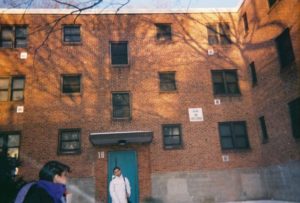 Wendy Luttrell, Professor of Urban Education and Social-Personality Psychology, investigates the ways young people participate in social structures in her visual ethnography project Children Framing Childhoods. She asks them to take pictures of their family, school, and community life that “emphasize their participation in and insights about larger social structures, processes, and ideologies—including the global migration of people, poverty, gender, and the American Dream.”
Wendy Luttrell, Professor of Urban Education and Social-Personality Psychology, investigates the ways young people participate in social structures in her visual ethnography project Children Framing Childhoods. She asks them to take pictures of their family, school, and community life that “emphasize their participation in and insights about larger social structures, processes, and ideologies—including the global migration of people, poverty, gender, and the American Dream.”
Thirty-four (34) diverse, mostly immigrant children ages 10-12, took part. Their use of photography—the images they took and the explanations they provided served as a means of entry into their social and emotional worlds and complex self-identifications. In addition to extensive participant observation in their public elementary school, data include 1350 photographs collected over four years and 65 hours of videotaped interview data in which the children discuss the meanings of their own and each other’s pictures. While the camera is just one among many tools, photography is an especially useful medium through which young people make visible their social worlds and express matters of the heart. That said, understanding transnational childhoods “through children’s eyes” or capturing children’s “voices” is not a straightforward or simple task. This project challenges a notion of “voice” that assumes children speak as one, or with a singular voice. Gender, race, ethnicity, class, and immigrant status influence the photographs children take, and what children say about those pictures. And, there are shifts in how children discuss their photos depending on the context and audience—what is said to the interviewer may differ when compared to what is said in peer groups or to teachers. Most important, there is no single theoretical framework to understand the “complex life” of the images children make. There are multiple layers of meaning in any single photograph and children make deliberate choices to represent themselves and others, sometimes in an effort to “speak back” to dominant or stereotypical images of themselves.
The children were given disposable cameras and a series of prompts to guide their picture taking, including, “You have a cousin who is your same age and is moving to Worcester and the Columbus Park School. Take pictures of what you want her/him to know about your school, family and community.” Each child had four days and 27 exposures. After the photos were developed, my research assistant or I met with each child and asked her/him to tell us about the photos. Individual interviews were conducted in the school and lasted between half an hour and an hour. The following open-ended questions guided the conversation: “Tell me about this photo. What’s going on here? Why did you take it? What does it tell about your life and what is important to you?”


